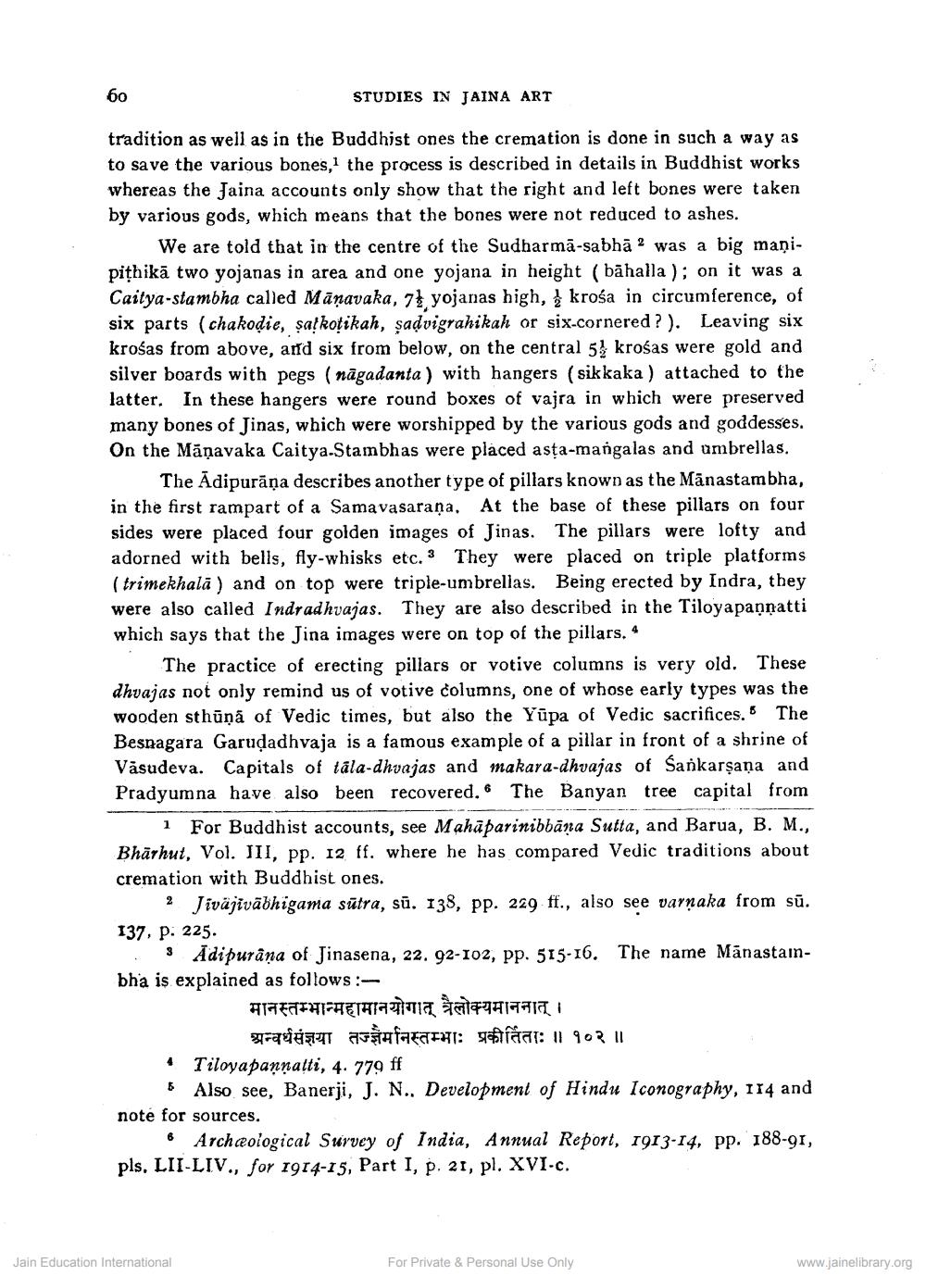________________
бо
STUDIES IN JAINA ART
tradition as well as in the Buddhist ones the cremation is done in such a way as to save the various bones, the process is described in details in Buddhist works whereas the Jaina accounts only show that the right and left bones were taken by various gods, which means that the bones were not reduced to ashes.
We are told that in the centre of the Sudharmā-sabhā 2 was a big manipițhikā two yojanas in area and one yojana in height (bāhalla ); on it was a Caitya-stambha called Mänavaka, 7} yojanas high, i krośa in circumference, of six parts (chakodie, şałkoţikah, sadvigrahikah or six-cornered?). Leaving six krośas from above, and six from below, on the central 5 krośas were gold and silver boards with pegs ( nāgadanta) with hangers (sikkaka ) attached to the latter. In these hangers were round boxes of vajra in which were preserved many bones of Jinas, which were worshipped by the various gods and goddesses. On the Māņavaka Caitya.Stambhas were placed asta-mangalas and umbrellas.
The Adipurāņa describes another type of pillars known as the Mānastambha, in the first rampart of a Samavasaraña. At the base of these pillars on four sides were placed four golden images of Jinas. The pillars were lofty and adorned with bells, fly-whisks etc. 3 They were placed on triple platforms ( trimekhala ) and on top were triple-umbrellas. Being erected by Indra, they were also called Indradhvajas. They are also described in the Tiloyapannatti which says that the Jina images were on top of the pillars.
The practice of erecting pillars or votive columns is very old. These dhvajas not only remind us of votive columns, one of whose early types was the wooden sthūņā of Vedic times, but also the Yüpa of Vedic sacrifices. The Besnagara Garudadhvaja is a famous example of a pillar in front of a shrine of Vasudeva. Capitals of tāla-dhvajas and makara-dhvajas of Sankarşaņa and Pradyumna have also been recovered. 6 The Banyan tree capital from
For Buddhist accounts, see Mahāparinibbāna Sutta, and Barua, B. M., Bhārhut, Vol. II, pp. 12 ff. where he has compared Vedic traditions about cremation with Buddhist ones.
2 Jiväjivābhigama sūtra, sū. 138, pp. 229 ff., also see varnaka from sū. 137, p. 225.
3 Adipurâna of Jinasena, 22. 92-102, pp. 515-16. The name Mānastambha is explained as follows:
मानस्तम्भान्महामानयोगात् त्रैलोक्यमाननात् ।
अन्वर्थसंज्ञया तज्ज्ञनिस्तम्भाः प्रकीर्तिताः ॥ १०२ ॥ • Tiloyapannatti, 4. 779 ff
$ Also see, Banerji, J. N., Development of Hindu Iconography, 114 and note for sources.
6 Archeological Survey of India, Annual Report, 1913-14, pp. 188-91, pls. LII-LIV., for 1914-15, Part I, p. 21, pl. XVI.C.
Jain Education International
For Private & Personal Use Only
www.jainelibrary.org




